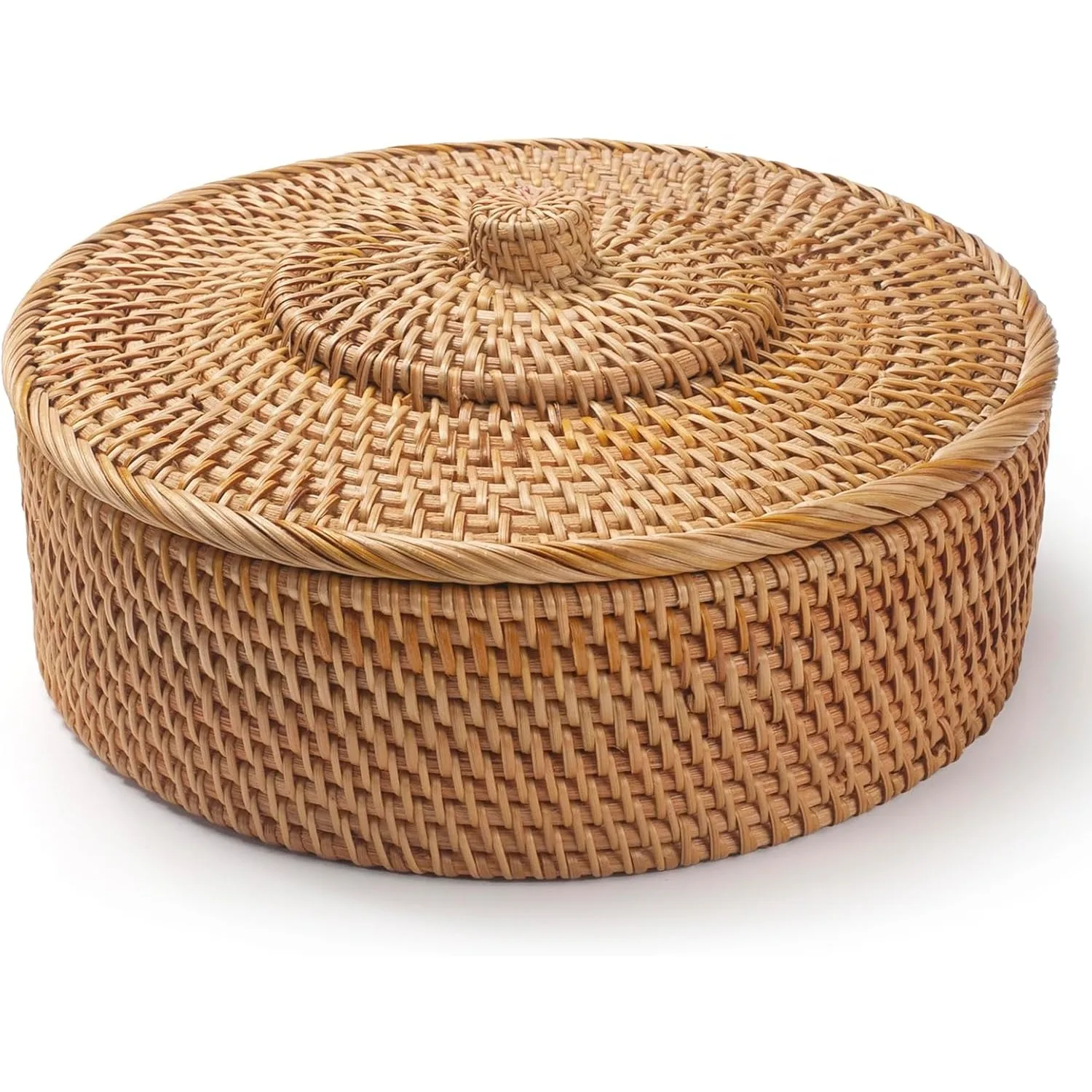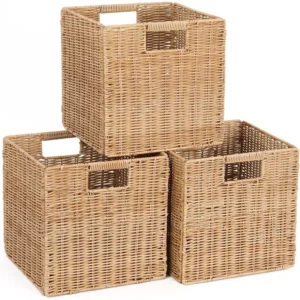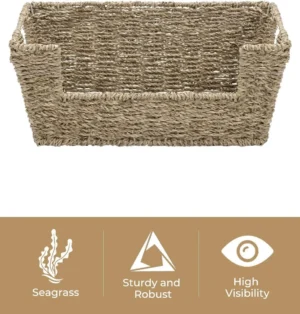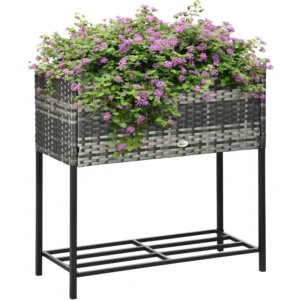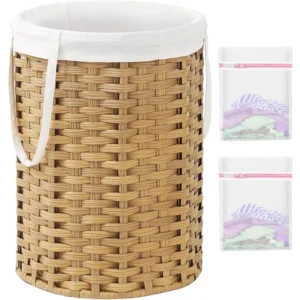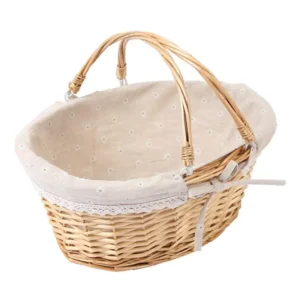Why Minimalist Wicker Makes Perfect Sense for Small Spaces
Living in compact spaces requires thoughtful furniture choices that maximize both function and style. Minimalist wicker furniture offers the perfect solution for small living areas by combining clean lines and simple designs with the natural texture of woven materials. This harmonious pairing creates pieces that feel light and airy while adding organic warmth to your space.
What makes minimalist wicker so ideal for small spaces? First, its inherent visual lightness. The woven structure creates a sense of transparency that allows light to filter through, making rooms feel more open and spacious. Unlike bulky, solid furniture that can overwhelm tight quarters, wicker’s airy quality helps maintain visual flow throughout a room.
The minimalist approach emphasizes only what’s essential—furniture that serves a clear purpose without unnecessary embellishments. When applied to wicker, this philosophy results in pieces that offer practical functionality while their natural textures add interest without visual clutter. This balance is particularly valuable in compact living, where organizing laundry wicker baskets and other storage solutions must integrate seamlessly into your overall design scheme.
Minimalist wicker furniture also offers remarkable versatility. From chairs and tables to storage pieces, these items adapt to multiple functions while maintaining a cohesive aesthetic throughout your home. Their neutral tones and natural materials complement virtually any design style, making them ideal foundational pieces for small spaces.
With their lightweight construction, most wicker pieces can be easily moved and rearranged as needed—another significant advantage when space is at a premium. Our collection of rattan storage baskets demonstrates how beautiful minimalist design can address practical storage needs while enhancing your décor.
Essential Minimalist Wicker Pieces for Your Compact Living Area
Creating a functional yet stylish living area in a small space requires furniture that serves multiple purposes without overwhelming the room. Minimalist wicker pieces excel in this environment, offering practical solutions with an airy aesthetic.
Streamlined Seating Options
- Compact Wicker Sofas and Loveseats: Look for designs with slim arms and elevated legs that create visual space underneath. Ideal dimensions include widths of 60-70 inches (152-178 cm) for sofas and 45-55 inches (114-140 cm) for loveseats.
- Armchairs with Slim Profiles: Choose chairs with open weaves and minimal framing. The best options typically measure about 25-30 inches (63-76 cm) wide, offering comfortable seating without dominating the room.
- Stackable Accent Chairs: These can be stored away when not needed and brought out for guests, measuring approximately 18-22 inches (45-56 cm) wide.
Space-Saving Tables
- Wicker Coffee Tables with Storage: Tables featuring interior compartments or lower shelves provide valuable storage while serving as centerpieces. Look for heights of 16-18 inches (40-46 cm) with slender profiles.
- Nesting Table Sets: These versatile pieces can be separated when needed and tucked together when space is at a premium.
- Slim Side Tables: Options with diameters of 14-18 inches (35-46 cm) offer functionality without consuming precious floor space.
Multifunctional Storage Pieces
The beauty of minimalist wicker for small spaces lies in its ability to combine decoration with utility. Storage ottomans serve as seating, tables, and hidden storage all in one compact footprint. Likewise, wicker benches with integrated storage compartments offer seating and organization in entry areas or at the foot of beds.
For those struggling with limited storage, slim profile wicker bookcases with open backs maintain visual airiness while providing ample display and storage space. Similarly, neutral-toned wicker baskets offer flexible storage solutions that complement the minimalist aesthetic.
When selecting pieces, prioritize items with clean lines, simple silhouettes, and minimal ornamentation. The most effective minimalist wicker furniture combines natural materials with metal or glass elements for a contemporary feel that works beautifully in small spaces. Our curated collection of wicker storage baskets pairs perfectly with these furniture pieces to create cohesive storage solutions throughout your home.
Minimalist Wicker Dining Solutions for Limited Square Footage
Creating an inviting dining space in a compact home requires furniture that combines style, function, and space efficiency. Minimalist wicker dining pieces offer an elegant solution, providing necessary dining functionality without overwhelming limited square footage.
Bistro-Style Wicker Sets
Small-scale bistro sets represent one of the most practical options for tight dining spaces. Look for:
- 2-Seater Sets: Intimate table and chair combinations measuring approximately 24-30 inches (60-76 cm) in diameter
- Folding Options: Tables with drop-leaf designs that expand from 24 inches (60 cm) to 36 inches (91 cm) when needed
- Round Shapes: Circular tables eliminate sharp corners that can interrupt traffic flow in tight spaces
Space-Efficient Dining Chairs
The right chair design makes a significant difference in small dining areas:
- Armless Designs: Chairs without arms typically measure 16-18 inches (40-46 cm) wide, allowing more seating around limited table space
- Stackable Options: Chairs that stack neatly when not in use free up valuable floor space
- Lightweight Construction: Wicker’s inherent lightness makes rearranging simple when needed
Counter and Bar Solutions
For truly compact spaces, counter-height solutions offer excellent alternatives:
- Wicker Bar Stools: These provide dining functionality at kitchen counters or islands without requiring dedicated dining space
- Backless Designs: Options measuring 15-18 inches (38-46 cm) in width tuck completely under counters when not in use
- Adjustable Height Models: These adapt to various counter heights, maximizing versatility

When selecting wicker dining furniture for small spaces, prioritize pieces with open, airy weaves that create visual lightness. The ideal weight capacity for daily use typically ranges from 250-300 pounds (113-136 kg), ensuring durability without excessive bulk. Materials that combine wicker with slim metal frames offer the best balance of strength and visual delicacy.
For even more space efficiency, consider extendable table options with wicker elements that can accommodate occasional guests while maintaining a minimal footprint for everyday use. These adaptable designs exemplify the practical versatility that makes minimalist wicker such an excellent choice for compact dining areas.
Bedroom Wicker Essentials: Creating Tranquility in Small Sleeping Quarters
Creating a peaceful bedroom retreat in limited square footage requires furniture that feels light and unobtrusive. Minimalist wicker pieces excel in this environment, bringing natural texture and visual airiness to small sleeping spaces.
Space-Conscious Bed Options
- Minimalist Wicker Headboards: These create a focal point without the bulk of a complete bed frame, typically extending 36-42 inches (91-107 cm) above the mattress top
- Platform Bed Frames: Designs with woven wicker panels and elevated bases (about 12-14 inches/30-36 cm high) create useful under-bed storage space
- Slim-Profile Designs: Bed frames with minimal footprints extend just 2-3 inches (5-8 cm) beyond mattress dimensions
The open, woven structure of wicker headboards allows light to filter through, creating a sense of spaciousness that solid headboards cannot match. Many minimalist designs combine wicker with slim metal or wood framing for a contemporary look that complements various bedroom styles.
Compact Nightstand Solutions
In small bedrooms, nightstands must maximize function without consuming precious floor space:
- Wall-Mounted Wicker Shelves: These eliminate floor footprint entirely while providing bedside storage
- Slender Wicker Tables: Options measuring 12-16 inches (30-41 cm) wide provide essential surface area without overwhelming the room
- Integrated Storage: Look for designs with small drawers or shelving to maximize utility
Vertical Storage Options
When floor space is limited, thinking vertically becomes essential:
- Tall, Narrow Wicker Dressers: Units measuring 24-30 inches (61-76 cm) wide but 48+ inches (122+ cm) tall provide ample storage with minimal floor space
- Hanging Wicker Organizers: Wall-mounted or over-door options add storage without consuming floor area
- Wicker Storage Ladders: These lean against walls, utilizing vertical space for displaying and storing items
Our small wicker baskets provide ideal companions to these furniture pieces, fitting neatly into nightstands or dressers while maintaining the cohesive wicker aesthetic.
When selecting bedroom pieces, look for elevated designs with visible space underneath to create a sense of openness. Light natural finishes or whitewashed wicker works particularly well in small bedrooms, reflecting light and contributing to an airy atmosphere. The combination of minimalist design principles with wicker’s inherent texture creates bedroom furniture that feels both serene and interesting—perfect for small sleeping quarters.
Space-Optimizing Design Principles for Minimalist Wicker Furniture
Understanding key design principles can help you select and arrange minimalist wicker furniture to maximize both functionality and spaciousness in compact areas. These guidelines will transform how you approach furnishing small spaces.
Scale and Proportion
The relationship between furniture size and room dimensions fundamentally impacts how spacious an area feels:
- Choose wicker pieces that leave at least 30-36 inches (76-91 cm) of walkway space around them
- Select furniture that sits lower to the ground (16-18 inches/40-46 cm) to create more visual space above
- Maintain proportional balance—if using a larger wicker sofa, pair it with slimmer side tables
Remember that appropriately scaled furniture actually makes a room feel larger than multiple small pieces that create visual clutter.
Visual Lightness
Wicker’s inherent qualities can be leveraged to enhance spaciousness:
- Prioritize open-weave patterns that allow light to filter through
- Select pieces with visible space beneath them—raised at least 6-8 inches (15-20 cm) on legs
- Choose frames with thinner profiles and minimal bulk
- Incorporate wicker with glass elements for surfaces to maintain transparency
Color Theory for Small Spaces
The colors of your wicker pieces significantly impact spatial perception:
- Natural, light-toned wicker reflects more light, making spaces feel larger
- Maintain a limited color palette throughout the space (2-3 complementary colors)
- Consider whitewashed or bleached wicker for maximum brightness
- Use darker wicker pieces sparingly as accents rather than main elements
Strategic Placement
How you position your wicker furniture dramatically affects room flow:
- Arrange seating perpendicular to walls rather than pushing everything against them
- Create conversation areas with furniture forming a C-shape rather than a closed circle
- Position taller wicker pieces against walls, keeping lower items toward the center
- Utilize corners effectively with specially designed corner units
Many of these principles align with effortless laundry organization wicker baskets strategies, where thoughtful placement and scale considerations maximize functionality in limited spaces.
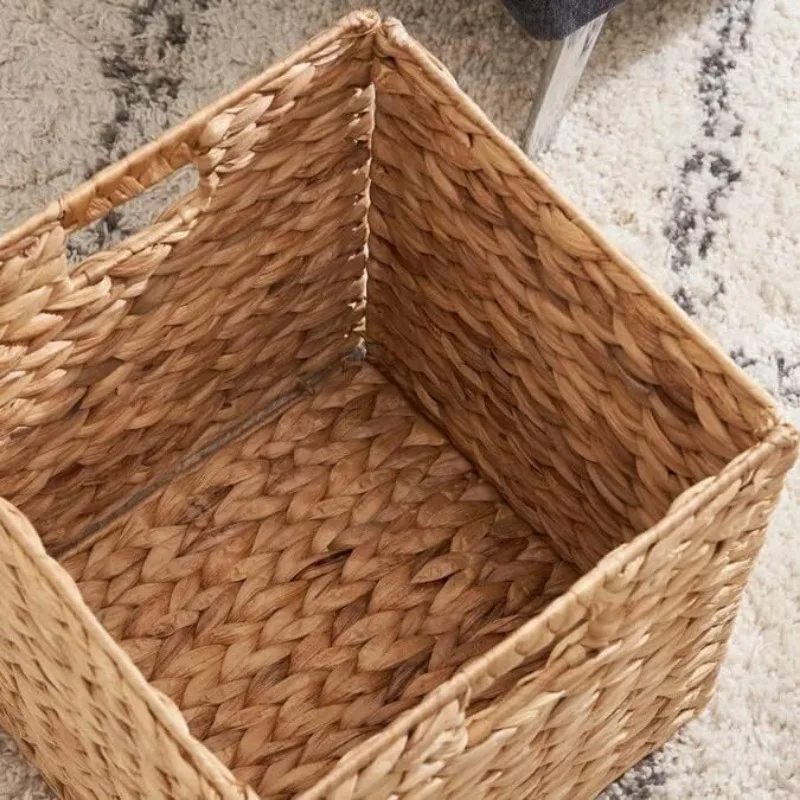
By applying these space-optimizing principles, you’ll create arrangements that feel intentional and spacious despite limited square footage. The goal is to select minimalist wicker pieces that provide essential function while maintaining visual flow throughout your compact living space.
Natural vs. Synthetic Wicker: Making the Right Choice for Your Small Space
When selecting minimalist wicker furniture for small spaces, understanding material differences helps ensure your pieces will perform beautifully and last for years. Both natural and synthetic wicker options offer distinct advantages depending on your specific needs.
Natural Wicker Materials
Natural wicker encompasses several plant-based materials, each with unique characteristics:
- Rattan: The most common natural wicker material, known for its strength and flexibility. The solid core creates sturdy furniture with a classic appearance.
- Seagrass: Offers a more textured look with subtle color variations. Typically more rigid than rattan but brings unique natural patterning.
- Bamboo: Provides exceptional strength with a distinctive jointed appearance. Often combined with other wicker materials for structural elements.
- Water Hyacinth: Features a chunkier weave with excellent texture. Best for accent pieces or areas with minimal direct sunlight.
Natural wicker brings unmatched authenticity and organic warmth to small spaces. Its subtle color variations and unique textures add visual interest without overwhelming compact areas. However, natural materials require more protection from moisture and direct sunlight, making them best suited for indoor use in controlled environments.
Synthetic Wicker Benefits
Modern synthetic wicker addresses many limitations of natural materials:
- Weather Resistance: Withstands moisture, humidity, and temperature fluctuations without warping
- UV Stability: Resists fading and deterioration from sun exposure
- Low Maintenance: Typically requires only occasional cleaning with mild soap and water
- Durability: Maintains its appearance and structural integrity for many years
- Consistency: Offers uniform color and pattern throughout all pieces
For small balconies, sunrooms, or spaces with varying environmental conditions, synthetic wicker provides exceptional versatility. High-quality versions closely mimic the appearance of natural materials while offering superior performance.
Comparison Table: Natural vs. Synthetic Wicker for Small Spaces
| Factor | Natural Wicker | Synthetic Wicker |
|---|---|---|
| Appearance | Authentic natural variations | Consistent coloration |
| Durability | 5-10 years with proper care | 10-20 years with minimal care |
| Maintenance | Regular dusting, periodic conditioning | Simple washing, minimal upkeep |
| Weather Resistance | Limited; primarily indoor use | Excellent; suitable for indoor/outdoor |
| Weight | Generally lighter | Slightly heavier, more stable |
| Sustainability | Renewable resource | Recyclable depending on type |
| Cost | Typically higher initially | More affordable, better long-term value |
For guidance on maintaining both types of wicker furniture, our guide on best wicker baskets laundry organization contains transferable care principles. If prioritizing natural materials, our rattan baskets collection showcases the beauty and versatility of this traditional wicker material.
Your selection should ultimately reflect your specific small-space conditions, maintenance preferences, and aesthetic priorities. For most compact indoor living spaces, high-quality natural wicker creates an unmatched organic feel, while synthetic options provide greater flexibility for challenging environments.
How to Care for and Maintain Your Minimalist Wicker Furniture
Proper maintenance ensures your minimalist wicker furniture remains beautiful and functional for years to come. Following these simple care routines will protect your investment and keep your small space looking its best.
Regular Cleaning Routine
Establishing a consistent cleaning schedule prevents dirt buildup and protects the wicker material:
- Use a soft brush attachment on your vacuum cleaner weekly to remove dust from woven surfaces
- Wipe natural wicker with a barely damp cloth monthly; synthetic wicker can handle slightly more moisture
- For deeper cleaning (every 3-4 months), use a solution of mild soap and water applied with a soft cloth
- Always ensure furniture dries completely after any cleaning involving moisture
- For natural wicker, use compressed air cans to blow dust from tight weaves
Seasonal Maintenance Tips
- Spring/Summer: Check outdoor or sunroom pieces for sun damage; rotate furniture to ensure even exposure
- Fall: Apply a light coat of furniture wax to natural wicker before humidity drops in heating season
- Winter: Maintain indoor humidity levels between 40-60% to prevent natural wicker from drying and cracking
- Year-round: Tighten any loose screws or connectors quarterly
Protection Strategies
Preventative measures significantly extend furniture life:
- Position wicker furniture away from direct sunlight or use sheer curtains to filter UV rays
- Apply furniture-grade UV protectant spray annually to both natural and synthetic pieces
- Use furniture pads under legs to prevent floor damage and reduce stress on weaving
- Consider furniture covers for seasonal storage or during extended absences
Quick-Fix Solutions
Address minor issues promptly to prevent larger problems:
- For loose weaving, gently push strands back into place and secure with a tiny drop of wood glue
- Treat small breaks in natural wicker by applying a damp cloth until pliable, then reshape and secure
- Touch up scratches on painted wicker with matching paint using a fine artist’s brush
- Replace individual damaged strands rather than attempting extensive repairs
The maintenance principles that keep your furniture looking its best also apply to organizational elements—our guide on wicker baskets elegant laundry solution provides complementary care techniques for all your wicker items.
With minimal effort, your minimalist wicker furniture will continue providing both beauty and functionality in your small space for many years. The time invested in proper care ensures these pieces remain highlight elements in your compact living environment rather than becoming worn detractors.
Is Minimalist Wicker Furniture Right for Your Specific Small Space?
Before investing in minimalist wicker furniture, it’s important to evaluate whether this style truly suits your particular small space situation. Consider these key factors to determine compatibility:
Space Assessment Questions
- Does your space receive adequate natural light? Wicker looks best in well-lit areas that showcase its texture.
- What’s the humidity level in your space? Very dry environments may require humidifiers for natural wicker.
- Do you need primarily visual lightness or physical durability? This helps determine natural versus synthetic choices.
- What existing furniture will remain, and how will wicker complement these pieces?
- Are sound considerations important? Wicker may creak slightly with movement compared to fully upholstered options.
Lifestyle Compatibility
Your daily routines significantly impact furniture suitability:
- For Pet Owners: Consider synthetic wicker’s resistance to claws and easier cleaning; choose tighter weaves to prevent trapped pet hair.
- For Families with Children: Assess whether rounded corners and sturdy construction match your needs; evaluate cleaning requirements for inevitable spills.
- For Frequent Entertainers: Determine if pieces can accommodate guest numbers or be easily moved/reconfigured.
Design Style Integration
Minimalist wicker blends particularly well with several popular small-space design approaches:
- Scandinavian Minimalist: Light-colored wicker pairs beautifully with the warm simplicity of this style.
- Japandi: The natural materials in wicker complement this Japanese-Scandinavian hybrid aesthetic.
- Modern Coastal: Wicker’s organic texture enhances beachy, relaxed environments without overwhelming them.
- Boho Minimalist: Provides natural elements that balance this style’s selective use of pattern and texture.
Space-Type Considerations
Different small spaces present unique challenges:
- Studio Apartments: Open-weave wicker helps delineate zones without blocking sightlines.
- Tiny Houses: Look for multi-functional pieces that can serve several purposes.
- Small Rooms in Larger Homes: Consider scale proportionate to the specific room rather than the entire home.
For specialized solutions addressing unique space constraints, our small space wicker storage solutions provide additional insights tailored to particular spatial challenges.
The ideal candidates for minimalist wicker furniture are spaces that benefit from visual lightness, texture, and natural elements—particularly those with good natural light. If your lifestyle demands extremely high durability, frequent reconfiguration, or you prefer very streamlined contemporary aesthetics, you might want to incorporate wicker as accent pieces rather than primary furniture.
Finding Quality Minimalist Wicker Furniture for Small Spaces: What to Look For
Identifying high-quality minimalist wicker furniture requires attention to specific construction details and materials. These guidelines will help you make informed purchasing decisions that ensure longevity and satisfaction.
Construction Quality Indicators
- Tight, Consistent Weaving: Examine pieces for uniform pattern density without gaps or irregularities
- Reinforced Stress Points: Quality pieces feature additional support at corners, joints, and weight-bearing areas
- Smooth, Finished Edges: No sharp or frayed strands should be visible anywhere on the piece
- Solid Frame Foundation: Gently shake the furniture to check for wobbling—quality pieces remain stable
- Sealed Surfaces: Natural wicker should have a clear protective finish; synthetic wicker should have UV-resistant coating
At Tidy Treasure, we evaluate each item’s construction quality before adding it to our collection, ensuring you receive only the finest wicker furniture pieces.
Material Assessment
- For Natural Wicker: Look for uniformity in color with a slight sheen indicating proper sealing
- For Synthetic Wicker: Check for UV stabilizers in the material specifications to prevent fading
- Weight Capacity: Quality pieces clearly state weight limits—look for minimum capacities of 250-300 pounds (113-136 kg) for seating
- Material Thickness: Examine strand thickness—too thin indicates potential durability issues
Frame Construction
The underlying structure significantly impacts furniture quality:
- Hardwood Frames: Provide excellent durability for natural wicker pieces
- Aluminum Frames: Offer lightweight strength ideal for both indoor and outdoor use
- Steel Frames: Provide maximum stability but should be powder-coated to prevent rust
- Connection Methods: Screwed connections generally outperform glued joints for longevity
Weaving Technique Evaluation
Different weaving patterns affect both aesthetics and durability:
- Close Weave: More durable but visually heavier
- Open Weave: Creates visual lightness but may be less sturdy
- Herringbone Pattern: Offers excellent structural integrity with visual interest
- Diamond Pattern: Provides good strength with classic aesthetic appeal
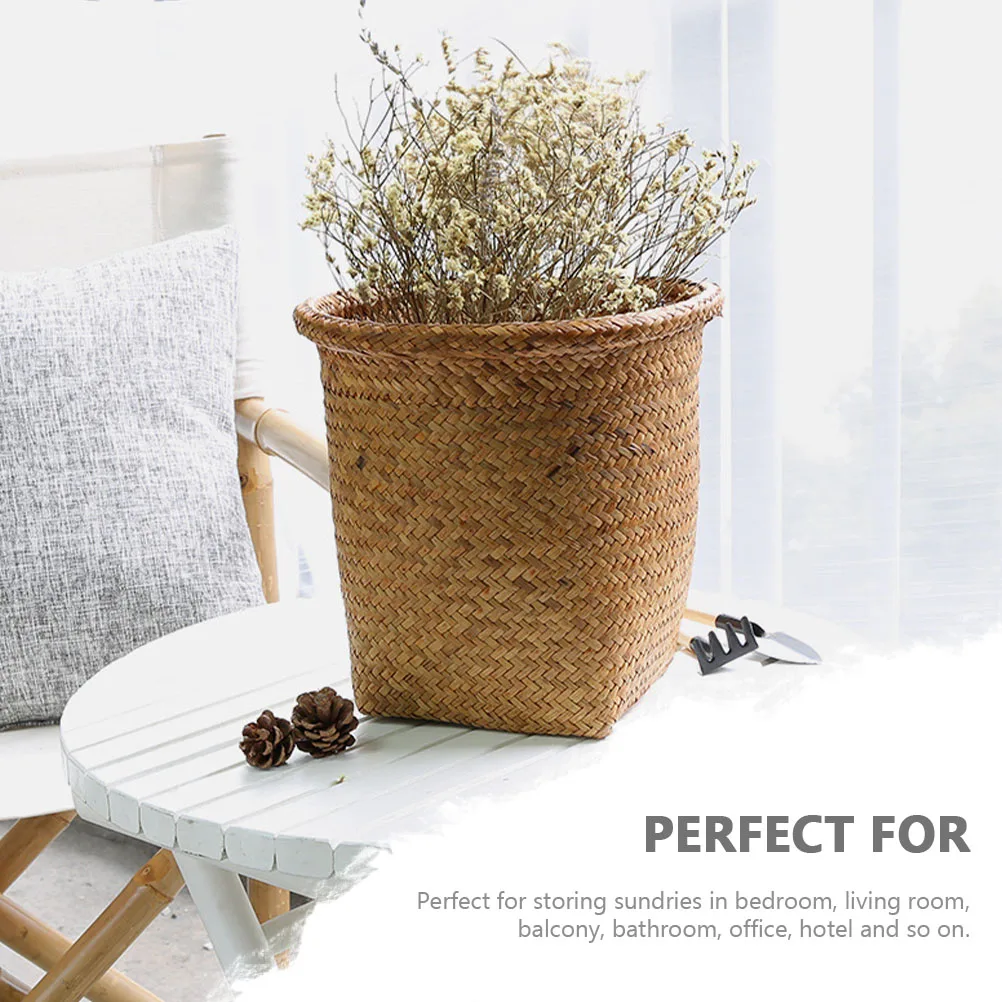
Our wicker shelf baskets demonstrate these quality indicators at a smaller scale, making them perfect companions to larger furniture pieces.
When shopping, don’t hesitate to request close-up photos of weaving joints and construction details from online retailers. For in-person shopping, bring a small flashlight to examine interior construction elements. Quality minimalist wicker furniture represents an investment that, when properly selected, will serve your small space beautifully for many years.
Black Wicker Baskets, Rattan Storage Baskets, Tall Wicker Baskets, Wicker Shelf Baskets, Woven Storage Baskets
5-Tier Distressed Black Wood Frame Storage Tower with Removable Wicker Baskets for Home Organization$715.80 Select options This product has multiple variants. The options may be chosen on the product pageRattan Shelf Baskets, Rattan Storage Baskets, Small Wicker Baskets, Square Wicker Baskets
Square Plastic Wicker Storage Baskets Set of 3 with Collapsible Design for Cube Storage Organization$185.47 Select options This product has multiple variants. The options may be chosen on the product pageWicker Baskets with Handles, Wicker Storage Baskets, Woven Storage Baskets
$137.92 Select options This product has multiple variants. The options may be chosen on the product pageRattan Shelf Baskets, Rattan Storage Baskets
$345.47 Select options This product has multiple variants. The options may be chosen on the product pageLarge Wicker Laundry Baskets, Rattan Laundry Baskets, Woven Laundry Hampers
$162.32 Select options This product has multiple variants. The options may be chosen on the product pageSmall Wicker Baskets, Wicker Picnic Baskets, Woven Storage Baskets
$55.63 Select options This product has multiple variants. The options may be chosen on the product page
Creative Ways to Style Minimalist Wicker in Tight Quarters
Once you’ve selected quality minimalist wicker furniture, thoughtful styling transforms these pieces from simple functional items into cohesive design elements. These creative approaches help maximize both aesthetic appeal and practical function in limited spaces.
Material Pairing Strategies
Create visual harmony by thoughtfully combining wicker with complementary materials:
- Layer soft textiles like linen or cotton throws to soften wicker’s texture
- Incorporate small metal accents (brass or black iron) for contemporary contrast
- Add ceramic elements in similar tones to enhance the natural material story
- Integrate glass surfaces to maintain visual openness while adding functionality
The interplay between wicker’s organic texture and these complementary materials adds depth to your space without requiring additional square footage.
Accessorizing with Restraint
Following minimalist principles, select accessories carefully:
- Choose 2-3 statement pieces rather than multiple small items
- Select textiles with subtle texture rather than bold patterns
- Incorporate plants to enhance the natural quality of wicker
- Use wall-mounted elements to add visual interest without consuming floor space
Creating Visual Focal Points
Even in tight quarters, establishing a focal point helps anchor the space:
- Position your largest wicker piece against the longest wall
- Highlight a statement chair with proper lighting
- Create asymmetrical balance by pairing a larger wicker item with smaller complementary pieces
- Use area rugs to define zones around key wicker furniture
Color Strategy for Small Spaces
Develop a cohesive color approach that enhances your wicker elements:
- Build a palette of 3-4 colors that complement your wicker’s natural tones
- Use the 60-30-10 rule: 60% primary color, 30% secondary color, 10% accent color
- Consider tone-on-tone variations for sophistication without visual busyness
- Incorporate small colorful accents that can be easily changed seasonally
Our guide on wicker baskets Scandinavian simplicity warmth offers additional styling inspiration that translates beautifully to minimalist wicker furniture arrangements.
Remember that in small spaces, negative space (empty areas) is just as important as the furniture itself. Allow your wicker pieces room to “breathe” rather than crowding too many items together. This restraint honors true minimalist principles while showcasing the natural beauty of your carefully selected wicker furniture.
Frequently Asked Questions About Minimalist Wicker for Small Spaces
How durable is wicker furniture for daily use?
Quality wicker furniture is surprisingly durable when properly constructed. Natural wicker typically lasts 5-10 years with proper care, while synthetic versions can last 10-20 years or more. Look for pieces with reinforced frames and tight, consistent weaving patterns. For high-traffic areas or households with children and pets, synthetic wicker generally offers superior durability while maintaining the minimalist aesthetic.
What weight capacity can I expect from minimalist wicker furniture?
Most well-constructed wicker seating supports between 250-300 pounds (113-136 kg) per seat. Minimalist designs with metal frame reinforcement typically offer the highest weight capacities. Always check manufacturer specifications, as capacity varies significantly between pieces and construction methods.
How should I adapt wicker furniture for different climate conditions?
In dry climates, natural wicker may become brittle without sufficient humidity. Consider using a humidifier during winter months when heating systems further reduce moisture. In humid environments, ensure adequate air circulation around furniture to prevent mildew growth. For areas with significant temperature fluctuations, synthetic wicker provides greater stability and resistance to environmental changes.
Will wicker furniture complement my existing décor?
Minimalist wicker’s neutral tones and natural textures blend remarkably well with most design styles. It pairs particularly well with Scandinavian, coastal, bohemian, and modern farmhouse aesthetics. For more contemporary spaces, look for wicker pieces with cleaner lines and metal accents. The key is selecting pieces with weaving patterns that echo existing textures in your space.
How can I prevent wicker furniture from making noise?
Some creaking is normal with natural wicker furniture as it adjusts to weight. To minimize noise, ensure joints remain tight by checking connections periodically. Apply a small amount of beeswax to areas where natural wicker pieces rub against each other. For seat cushions, adding a thin layer of felt beneath can reduce friction sounds.
Is it possible to repair damaged wicker furniture?
Minor damage to wicker furniture is often repairable. For loose strands, apply a small drop of wood glue and clamp until dry. For broken pieces in natural wicker, soak the area with a damp cloth until pliable, then reshape and secure with appropriate adhesive. More extensive damage typically requires professional repair. Synthetic wicker is generally more difficult to repair but less prone to damage initially.
How Does Minimalist Wicker Compare to Other Small-Space Furniture Options?
When furnishing small spaces, it’s helpful to understand how minimalist wicker compares to other popular material choices. This comparison highlights wicker’s unique advantages and potential limitations relative to alternatives.
Material Comparison Overview
| Feature | Minimalist Wicker | Metal Furniture | Acrylic Furniture | Solid Wood |
|---|---|---|---|---|
| Visual Weight | Light, airy | Moderate to light | Very light | Heavy |
| Actual Weight | Light to moderate | Moderate to heavy | Light | Heavy |
| Durability | 5-20 years (depending on type) | 10-20+ years | 5-10 years | 20+ years |
| Maintenance | Moderate | Low | Low | Moderate |
| Cost Range | $$ – $$$ | $$ – $$$ | $$$ – $$$$ | $$$ – $$$$ |
| Warmth/Texture | High | Low | Low | High |
| Eco-Friendliness | High (natural), Moderate (synthetic) | Moderate | Low | High |
Visual Impact Analysis
Minimalist wicker creates a unique visual experience in small spaces:
- Texture Contribution: Wicker adds natural texture that softens spaces without overwhelming them—something metal and acrylic cannot provide
- Light Interaction: The semi-transparent nature of woven wicker interacts with light differently than solid materials, creating interesting shadow play
- Perceived Weight: Wicker pieces often appear lighter than they actually are, contributing to a sense of spaciousness
Cost Considerations
While initial price points vary widely, consider these cost factors:
- Quality wicker furniture typically costs less than comparable solid wood pieces
- Synthetic wicker offers better long-term value in challenging environments compared to natural materials
- Metal furniture often requires additional textile elements (cushions, covers) that increase overall cost
- Acrylic typically commands premium pricing despite shorter lifespan
Versatility Factors
Each material offers different adaptability to small space challenges:
- Wicker excels in creating visual lightness while adding natural texture
- Metal provides industrial aesthetic with structural strength in minimal dimensions
- Acrylic creates near-invisible profiles ideal for very small spaces
- Wood brings warmth but requires more careful sizing for small areas
Wicker’s unique position combines visual lightness (similar to acrylic) with organic warmth (similar to wood), making it particularly well-suited for small spaces where both openness and comfort are priorities. For spaces where absolute durability or extremely contemporary aesthetics are paramount, metal or acrylic might prove more suitable for primary pieces, with wicker serving as complementary elements.
The ideal approach for many small spaces involves thoughtfully combining these materials—perhaps using wicker for seating, glass or acrylic for tables, and metal for structural elements—to create a balanced environment that feels both spacious and inviting.

